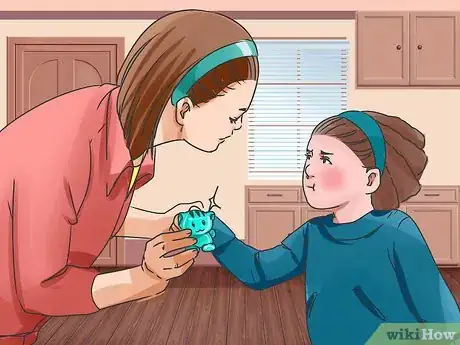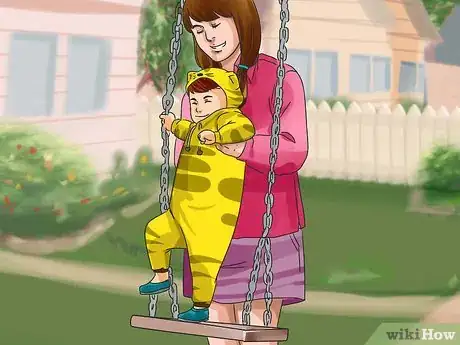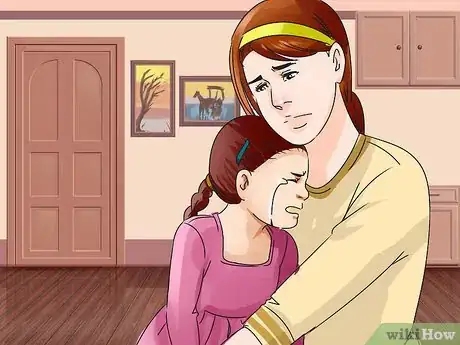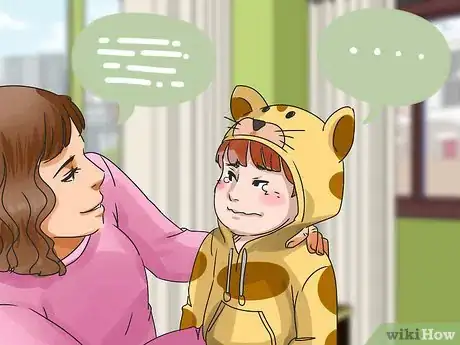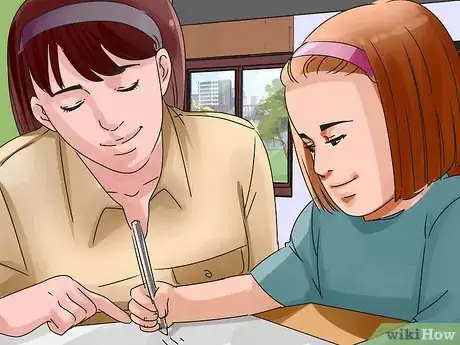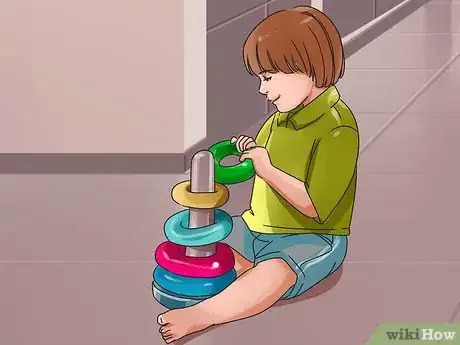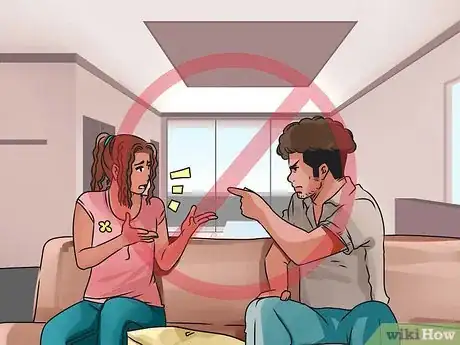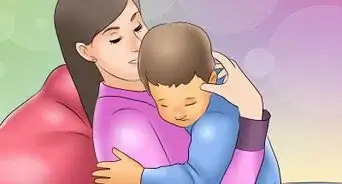This article was co-authored by Wits End Parenting. Wits End Parenting is a parent-coaching practice based in Berkeley, California specializing in strong-willed, “spirited” children with impulsivity, emotional volatility, difficulty “listening,” defiance, and aggression. Wits End Parenting's counselors incorporate positive discipline that is tailored to each child’s temperament while also providing long-term results, freeing parents from the need to continually re-invent their discipline strategies.
There are 8 references cited in this article, which can be found at the bottom of the page.
This article has been viewed 25,152 times.
Disciplining a child often includes some level of punishment. However, it's important to remember that the ultimate goal of punishment is to change behavior; not to hurt the child. Since children respond differently to behavioral interventions based upon their age and developmental level, discipline will look different at each developmental stage. It is important to learn how to apply age appropriate punishment without sacrificing your child's dignity or self-esteem.
Steps
Redirecting Toddler Behavior
-
1Instruct the child to stop. It is normal for toddlers to try to assert control over their environment. However, when their desire for autonomy results in aggression, destruction, or it jeopardizes their own safety, it's your job to intervene.[1] Toddlers are still quite nonverbal and unable to process a lot of verbal exchange. [2] Therefore, it's important to stick to very brief instructions.
- Typically the word no is overused and children are desensitized to it. In urgent situations such as a hot oven, use the word, "no," but in other situations is it better to offer a statement of fact that also gives the child a reason why the behavior is not correct. For example, instead of "no hitting people" parents should say "people are not for hitting." Or instead of "no throwing of toys" parents should say "toys are not for throwing."
-
2Alter the unwanted behavior. Immediately after you give the brief verbal instruction, modify the behavior.[3] This can be done by removing the child from the unwanted behavior or situation.[4] For example, if the child is pushing another child, you can remove him/her hands from the other child by placing him/her arms at him/her sides. Alternatively, you could pick him/her up and place him/her a few feet away from the other child.
- If he/she is trying to access something that is dangerous, take the item from him/her. For example, if he/she is holding a breakable glass, you can take the object from him/her.
Advertisement -
3Redirect the toddler's attention to another activity. Toddlers have very short attention spans and can be easily distracted. Try to engage him/her with an alternate activity.[5]
- For example, if he/she is being aggressive with another child on the playground because he/she wants to play with a ball, you could distract him/her by taking him/her to the swings. Be creative; toddlers are easily entertained.[6]
- You should continue to monitor the child to make sure that the behavior does not recur.
-
4Remove the child from the situation if a tantrum occurs. Toddlers often have trouble controlling their emotions. This behavior is not always willful disobedience but usually demonstrates their low frustration tolerance.[7] Help your child to regain control by removing him/her from the place of misbehavior.
- You should be empathetic with the child but still establish limits. Do not yell at the child or disrespect him/her in anyway. The point is to help him/her regain emotional control, so that means that you have to remain emotional control yourself.
-
5Hold the child gently. When a child is having a temper tantrum, he/she may not willingly stay were you place him/her. To avoid injury to him or herself and to help him/her regain control, try gently but firmly holding him/her on your lap until him/she is calm again.[8]
- Toddlers are very vulnerable to feelings of abandonment, so be sure to never leave a toddler unsupervised in a timeout situation. Always remain with him/her.
-
6Reassure the toddler. Once he/she has regained emotional control, be sure to provide some verbal reassurance.[9] Again, it's important to keep the verbal exchange short so that he/she understands. You could say something like, “Looks like you're feeling better” or “Kaylee is calm now.”
-
7Reintroduce the toddler to another activity. Now that he/she is calm, redirect him/her to another activity.[10] It is best to guide him/her toward an activity that is not near the place where the tantrum occurred. This will help to prevent the recurrence of the unwanted behavior and tantrum.
Using Timeout with Young Children
-
1Select an area for timeout in advance. The area should be a safe, boring place that is not entertaining for the child.[11] Try to avoid high traffic areas and places that have distractions such as a television, toys, or other children.[12]
- The timeout area should be selected in advance so that you aren't distracted trying to find an appropriate space when misbehavior occurs.
-
2Give the child a warning. If your child is misbehaving, start by giving him/her a warning.[13] Make sure that the warning is clear and spoken in simple and concrete language that is easily understood. Emphasize choice and responsibility when giving consequences, such as, "Kylie, if you choose to hit your sister again, then you choose to take a timeout."
-
3Tell your child to take a timeout. If the behavior continues, it is time to immediately implement the consequence. Always follow through with the timeout; this way you will avoid making empty threats. If you don't follow through, then your child will learn to not take you seriously.
- Briefly tell your child why he/she is being required to take a timeout. Do not spend a lot of time talking and avoid arguing altogether. A simple statement such as, “You are going to timeout because you kicked the wall” is sufficient.
- Physically guide the child to a timeout area if he/she refuses to go on him/her own. Escort him/her gently but firmly by the arm or pick him/her up and take him/her to the timeout spot.
- Remain calm when your child misbehaves. Remember, misbehavior on some level is developmentally appropriate for children. It is your responsibility to model appropriate behavior.
-
4Set the timer. Determine how long the timeout should be based upon your child's age. Most child development experts agree that the appropriate timeframe for timeout is one minute per year of age.[14] Require your child to stay in timeout for the designated timeframe. A timer that sounds when the time is up will help you and your child keep track of the time.
- Your child may try to refuse to stay in timeout. If he/she tries to leave the timeout seat, gently and consistently guide him/her back to the chair.
-
5Resume normal activity. Reintroduce the child back into a positive activity when the appropriate amount of time elapses. If he/she is still engaging in agitated behavior when the timeout is over, it may be helpful to tell him/her that once he/she is calm that he/she is free to rejoin the rest of the family or him/her peers.
- Before resuming normal activities, you may want to have a discussion about what happened.[15] Don't berate or lecture the child but use the experience as a learning opportunity instead. For example, you could say, “Kicking the wall can leave holes in the wall. Let's try to use your words when you're frustrated."
Applying Consequences with Older Children and Teenagers
-
1Establish the rules. Make sure that all caretakers are on board with the rules. It is very important that everyone is on the same page with discipline so that the children are unable to split or undermine adults.
- Try to include your children in making some of the rules. However, it's okay to have some nonnegotiable rules on important issues like curfew, grade expectations, church attendance, or anything else that is important to your family.
- Identify “off limits” behavior.[16] Examples of off-limits behavior might include things like saying “I hate you,” engaging in aggressive behavior, calling people names, cheating, using profanity, or playing derogatory music. You choose the off-limits behavior that is the most appropriate for your lifestyle and establish rules around them.
- Make sure that the rules are concrete and specific so that there is no room for misinterpretation. For example, it is better to establish the rule “You must be home by 7pm” then to say “You must be home before it gets dark.”
-
2Decide on the consequences. Be sure to explain the consequences of any rule infractions in advance. The child or teenager should know exactly how violations will be enforced before any actual violation occurs.[17]
- Consequences should be things that can be easily implemented and you should always follow through with them. Empty threats will weaken your influence and your kids will learn to not take you or the rules as seriously.
- Try making a list of activities or privileges that your child enjoys. Withdrawal of these privileges can be effective consequences.
- Sometimes natural consequences are more appropriate. These consequences are the direct result of the child's actions and are not inflicted upon him/her by the parent. For example, the natural consequence that occurs when your daughter does not put him/her jeans into the hamper is that the jeans are not clean for school the next day.
- Natural consequences should ONLY be used if the child is not in danger of being harmed.
-
3Apply consequences consistently.[18] Be consistent with the application of consequences so that your child or teenager will take you seriously.[19] This means that if the rule is that your child is home by 7pm and he/she walks in at 7:15pm, then the consequence should be applied.
- If you child does show up late, particularly an older one, listen to what they have to say. They may have been caught up leaving a friends house, got stuck in traffic, had to wait a long queue at the shop, etc
- If there is no rule in place about a particular behavior when it occurs, then take time to establish the rule at that point.
- Do not alter natural consequences. For example, if your daughter's jeans were not washed because they were not in the hamper, do not do a special load of laundry just to accommodate him/her.
-
4Avoid arguing with your child.[20] Older children and teenagers are notorious for testing boundaries. If you have made the rules clear and he/she has clearly violated one or more of them, then the consequence is applied. If you find yourself in a fighting match with your child, it is okay to remove yourself from the no-win argument. Keep in mind that the consequence is still valid but you have removed yourself from the argument.
- It is important to empathize and recognize feeling prior to reaffirming the rule. For example, if your 13 year old is screaming, “It's not fair, Stacey was allowed to stay out until midnight,” you could respond by saying, “I can tell you are upset and feeling let down, but this is not Stacey's family and my decision is final."
- This approach should only be used if he/she continues to argue with you after you've already reminded him/her of the rule and the consequence of violating it. It minimizes the power struggle and makes it clear that the rule still stands.
Expert Q&A
Did you know you can get expert answers for this article?
Unlock expert answers by supporting wikiHow
-
QuestionWhat should I do when my child disobeys?
 Wits End ParentingWits End Parenting is a parent-coaching practice based in Berkeley, California specializing in strong-willed, “spirited” children with impulsivity, emotional volatility, difficulty “listening,” defiance, and aggression. Wits End Parenting's counselors incorporate positive discipline that is tailored to each child’s temperament while also providing long-term results, freeing parents from the need to continually re-invent their discipline strategies.
Wits End ParentingWits End Parenting is a parent-coaching practice based in Berkeley, California specializing in strong-willed, “spirited” children with impulsivity, emotional volatility, difficulty “listening,” defiance, and aggression. Wits End Parenting's counselors incorporate positive discipline that is tailored to each child’s temperament while also providing long-term results, freeing parents from the need to continually re-invent their discipline strategies.
Parenting Specialists
Warning
References
- ↑ Wits End Parenting. Parenting Specialists. Expert Interview. 5 March 2020.
- ↑ http://www.ncbi.nlm.nih.gov/pubmed/7630695/
- ↑ http://www.ncbi.nlm.nih.gov/pmc/articles/PMC2719514/
- ↑ Wits End Parenting. Parenting Specialists. Expert Interview. 5 March 2020.
- ↑ http://www.ncbi.nlm.nih.gov/pmc/articles/PMC2719514/
- ↑ Wits End Parenting. Parenting Specialists. Expert Interview. 5 March 2020.
- ↑ http://www.ncbi.nlm.nih.gov/pmc/articles/PMC2719514/
- ↑ http://www.ncbi.nlm.nih.gov/pmc/articles/PMC2719514/
- ↑ http://www.ncbi.nlm.nih.gov/pmc/articles/PMC2719514/
- ↑ http://www.ncbi.nlm.nih.gov/pmc/articles/PMC2719514/
- ↑ https://www.healthychildren.org/English/family-life/family-dynamics/communication-discipline/Pages/What-About-Punishment.aspx
- ↑ http://www.mayoclinic.org/healthy-lifestyle/infant-and-toddler-health/in-depth/parenting-tips-for-toddlers/art-20044684?pg=2
- ↑ http://www.mayoclinic.org/healthy-lifestyle/infant-and-toddler-health/in-depth/parenting-tips-for-toddlers/art-20044684?pg=2
- ↑ http://www.mayoclinic.org/healthy-lifestyle/infant-and-toddler-health/in-depth/parenting-tips-for-toddlers/art-20044684?pg=2
- ↑ https://www.healthychildren.org/English/family-life/family-dynamics/communication-discipline/Pages/What-About-Punishment.aspx
- ↑ http://greatergood.berkeley.edu/raising_happiness/post/deal_with_misbehaving_kids
- ↑ http://greatergood.berkeley.edu/raising_happiness/post/deal_with_misbehaving_kids
- ↑ Wits End Parenting. Parenting Specialists. Expert Interview. 5 March 2020.
- ↑ http://www.ncbi.nlm.nih.gov/pmc/articles/PMC2719514/
- ↑ http://www.ncbi.nlm.nih.gov/pmc/articles/PMC2719514/
- ↑ http://pediatrics.aappublications.org/content/101/4/723.full
- ↑ https://www.theatlantic.com/national/archive/2013/07/is-it-ever-okay-to-spank-a-child/278174/
- ↑ http://pediatrics.aappublications.org/content/101/4/723.full


